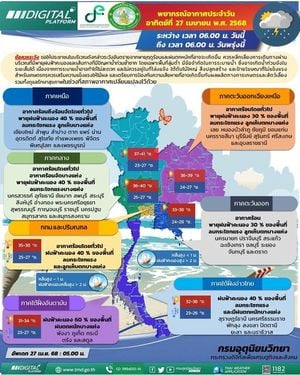On April 27, 2025, reports from Tuoi Tre highlighted the ongoing challenges faced by Vietnamese exporters at border gates, particularly in Lạng Sơn, as they navigate the complexities of exporting fruits and agricultural products to China. Despite concerns from drivers about long wait times and complicated procedures, Mr. Duy, a local official, assured that there are no significant traffic jams or congestion at the border. He emphasized that businesses must adhere to stringent export procedures and quality standards to ensure smooth operations.
According to Mr. Duy, the authorities at the border gates are committed to facilitating the customs clearance process for Vietnamese goods. However, he cautioned that exporters need to fulfill all necessary requirements, including compliance with inspection standards for cadmium and O gold in durian exports. "The customs clearance process in Vietnam is not long, but the waiting time for goods inspection takes a lot of time," noted a representative from a fruit exporting company at the Hữu Nghị border gate.
The representative expressed hope that the Vietnamese authorities would engage in negotiations with their Chinese counterparts to expedite the inspection process, thereby minimizing potential losses for businesses. The Dong Dang - Lạng Sơn Border Gate Economic Zone Management Board is actively working to liaise with Chinese officials to create favorable conditions for the clearance of Vietnamese goods.
In addition to these challenges, preliminary statistics from the General Department of Customs (Ministry of Finance) revealed a decline in Vietnam's overall import and export activities in the first half of April 2025. The total value of goods traded during this period reached $35.44 billion, marking a significant decrease of 10.6% compared to the latter half of March 2025. This downturn reflects a broader trend observed in the first quarter of the year, where the total import and export value for the country reached $237.97 billion, a 16.5% increase year-on-year.
Specifically, Vietnam's export value in the first half of April 2025 was reported at $16.75 billion, which is a 6.9% decline compared to the first half of March. More strikingly, this figure represents an 18.3% decrease from the record export value achieved in the second half of March. By April 15, 2025, the cumulative export value for the year had reached $119.62 billion, reflecting a 16.3% increase compared to the same period in 2024.
On the import side, the total value of goods imported into Vietnam during the first half of April 2025 was $18.69 billion, down 2.4% from the previous period. This decline is notable as it coincides with a broader increase in the overall import value for the year, which reached $118.35 billion—up 16.7% compared to the same timeframe last year.
Despite the fluctuations in trade values, the statistics indicate that foreign direct investment (FDI) enterprises continue to play a crucial role in Vietnam's trade landscape. The total export value from FDI enterprises reached $11.58 billion in the first half of April, a decrease of 20.1% compared to the previous period. However, the cumulative export value for these enterprises from the start of the year until mid-April stood at $85.03 billion, an increase of 15.8% year-on-year.
As the trade balance for the first half of April 2025 reflected a deficit of $1.94 billion, the overall trade balance from the beginning of the year to April 15 remained in surplus at $1.27 billion. This mixed picture of trade dynamics highlights the ongoing challenges and opportunities within Vietnam's export-import sector.
In summary, while Vietnamese exporters continue to face hurdles at border crossings, particularly regarding customs inspections, the overall trade statistics reveal a resilient growth trajectory compared to previous years. The government’s efforts to negotiate better conditions with China, alongside the adaptability of exporters, will be crucial in navigating this complex landscape. As the situation evolves, stakeholders in the agricultural sector are urged to stay informed and compliant with regulations to ensure the freshness and quality of their products reach consumers effectively.




